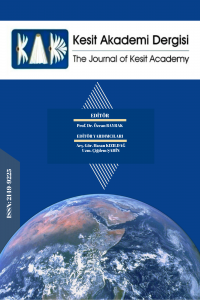FAZLA KİLOLU VEYA OBEZ YETİŞKİNLERİN GECE YEME DURUMLARININ DEĞERLENDİRİLMESİ
Amaç: Bu çalışmanın amacı fazla kilolu veya obez bireylerin gece yeme durumları ile obezite ilişkisinin değerlendirilmesidir. Yöntem: Tanımlayıcı tipte olan bu çalışma 2016 yılı Nisan-Mayıs ayı içerisinde Elazığ İl merkezinde araştırmaya katılmayı kabul eden fazla kilolu ve obez toplam 258 kişi üzerinde yürütüldü. Katılımcıların boy-kilo ölçümü yapılarak Beden Kütle İndeksleri BKİ hesaplandı. Verilerin toplanmasında Gece Yeme Anketi GYA kullanıldı. Veriler bilgisayar ortamında değerlendirilip anlamlılık düzeyi 0,05 olarak kabul edildi. Bulgular: Katılımcıların %61,2’si kadın n=158 , %38,8’ü erkek n=100 ve ortalama yaşı 36,14±14,47’dir. Katılımcıların %36,8’i n=95 lise mezunu olup, % 57,8’si n=149 evlidir. Tüm grubun %55,4’ü n=143 fazla kilolu, %44,6’sı n=115 obezdir. GYS olan ve olmayan gruplar arasında BKİ açısından anlamlı bir farklılık bulunmuştur p
Anahtar Kelimeler:
Gece Yeme Anketi, BKI, Obezite
FAZLA KİLOLU VEYA OBEZ YETİŞKİNLERİN GECE YEME DURUMLARININ DEĞERLENDİRİLMESİ
Objective: The aim of this study is to evaluate night eating syndrome and obesity in overweight and obese subjects. Method: This descriptive study was carried out on a total of 258 overweight and obese subjects who agreed to participate in the research in Elazig province center during April-May 2016. Body Mass Indexes BMI were calculated by measuring height-weight of participants. The data were collected using the Night Eating Syndrome NES . The data were evaluated on a computer and the level of significance was accepted as 0.05. Findings: 61.2% of the participants were female n = 158 , 38.8% were male n = 100 and the mean age was 36.14 ± 14.47. 36.8% n = 95 of the participants were high school graduates and 57.8% n = 149 were married. Of the whole group, 55.4% n = 143 were overweight and 44.6% n = 115 were obese. There was a significant difference in BMI between the groups with and without NES p
Keywords:
Night Eating Questionnaire, BMI, Obesity,
___
- Allison KC, Lundgren JD, O'Reardon JP, Martino NS, Sarwer DB, Wadden TA, et al. The Night Eating Questionnaire (NEQ): Psychometric properties of a measure of severity of the Night Eating Syndrome. Eat Behav 2008; 9:62-72.
- Aronoff NJ, Geliebter A, Zammit G. Gender and body mass index as related to the night-eating syndrome in obese outpatients. J Am Diet Assoc 2001:101:102– 104.141
- Arslan, F. C., Tiryaki, A., Aykut, D. S., Özkorumak, E., İlter, Z. Ç., & Günaydın, D. Ağır Ruhsal Bozukluğu Olan Kilolu veya Obez Ayaktan Hasta Grubunda Gece Yeme Sendromu Yaygınlığı.Türk Psikiyatri Dergisi 2015;26
- Atasoy N, Saraçlı Ö, Konuk N ve ark. (2014) Gece Yeme Anketinin Türkçe formunun psikiyatrik ayaktan hasta popülasyonunda geçerlilik ve güvenilirlik çalışması. Anadolu Psikiyatri Derg 15:238-247
- Cengiz, Y., Toker, S. G., Oğuz Karamustafalioğlu, K., Bakım, B., & Özçelik, B. Psikiyat- rik Ayaktan Hasta Popülasyonunda Gece Yeme Sendromunun Yaygınlığı ve Diğer Psikiyatrik Bozukluklarla Birlikteliği. In Yeni Symposium, 2011, (Vol. 49, No. 2).
- Ceru-Bjork C, Andersson I, Rossner S. Night eating and nocturnal eating-two different or similar syndromes among obese patients? Int J Obes Relat Metab Disord 2001; 25:365-372
- Colles SL, Dixon JB, O'Brien PE. Night eating syndrome and nocturnal snacking: asso- ciation with obesity, binge eating and psychological distress. Int J Obes (Lond) 2007;31:1722-1730.
- Collins JC, Bents JE. Behavioral and psychological factors in obesity. Journal of Lances- ter General Hospital, 4(4): 124-127, 2009.
- Gluck ME, Geliebter A, Satov T. Night eating syndrome is associated with depression, low self-esteem, reduced daytime hunger, and less weight loss in obese outpati- ents. Obes Res 2001; 9:264-267
- Küçükgöncü S, Tek C, Beştepe E, Musket C, Gülöksüz S. Clinical features of night ea- ting syndrome among depressed patients. Eur Eat Disord Rev. 2014;22(2):102– 108
- Marshall HM, Allison KC, O'Reardon JP, Birketvedt G, Stunkard AJ. Night eating syndrome among nonobese persons. Int J Eat Disord 2004; 35:217-222.
- Milano W, De Rosa M, Milano L, Capasso A. Night eating syndrome: an overview. J Pharm Pharmacol. 2012 Jan;64
- Napolitano MA, Head S, Babyak MA, Blumenthal JA. Binge eating disorder and night eating syndrome: psychological and behavioral characteristics. Int J Eat Disord 2001; 30:193-203
- Özey M. Kadınlarda Ağırlık Yönetiminin Yeme Tutum Davranışı Üzerine Etkisinin Değerlendirilmesi, Başkent Üniversitesi Sağlık Bilimleri Enstitüsü Beslenme Ve Diyetetik Bölümü Yüksek Lisans Tezi, Ankara,2014.
- Saraçlı Ö, Atasoy N, Akdemir A ve ark, The prevalance and clinical features of the night eating syndrome in psychiatry out patient population. Compr Psychiatry, 2015, 57:79-84
- Spaggiari MC, Granella F, Parrino L, Marchesi C, Melli I, Terzano MG. Nocturnal ea- ting syndrome in adults. Sleep 1994;17:339-344.
- Striegel-Moore RH, Franko DL, Thompson D, Affenito S, Kraemer H. Night eating: Prevalence and demographic correlates. Obesity 2006; 14:139−147.
- Stunkard AJ, Allison KC, Geliebter A, Lundgren JD, Gluck ME, O’Reardon JP. Deve- lopment of criteria for a diagnosis: lessons from the night eating syndrome. Compr Psychiatry 2008; doi:10.1016/j.comppsych. 2008.09.013.
- Stunkard A, Berkowitz R, Wadden T, Tanrikut C, Reiss E, Young L. Binge eating disor- der and the night eating syndrome. Int J Obes Relat Metab Disord 1996; 20:1-6
- Vander Wal.J.S.Night Eating Syndrome:A Criticl Review of The Literature.Clinical Psychology Review;32,49-59,2012
- Başlangıç: 2015
- Yayıncı: Asos Eğitim Bilişim Danışmanlık San. Tic. Ltd. Şti.
Sayıdaki Diğer Makaleler
FAZLA KİLOLU VEYA OBEZ YETİŞKİNLERİN GECE YEME DURUMLARININ DEĞERLENDİRİLMESİ
Fatoş UNCU, Bircan ULAŞ KADIOĞLU, Pınar SOYLAR
YENİ LİSAN HAREKETİ VE DİL PLANLAMASI
BİLİM, TEKNİK VE HEİDEGGER ÜZERİNE BİR NOT
ABDURRAHMAN ŞEREF BEY VE “COĞRAFYA-YI UMUMİ” KİTABI
ÜRETİMDE HATA ÖNLEME ARACI OLARAK POKA-YOKE SİSTEMİ VE BİR UYGULAMA ÖRNEĞİ
Murat ARSLANDERE, Mahmut TEKİN
KİŞİLİK VE MESLEK SEÇİMİ İLİŞKİSİ: TURİZM ÖĞRENCİLERİ ÜZERİNE BİR ARAŞTIRMA
Emin ARSLAN, Ediz GÜRİPEK, Cemal İNCE
ÖĞRETMEN ADAYLARININ ÖNYARGI VE AYRIMCILIĞA İLİŞKİN DENEYİMLERİNİN FENOMENOLOJİK ANALİZİ
